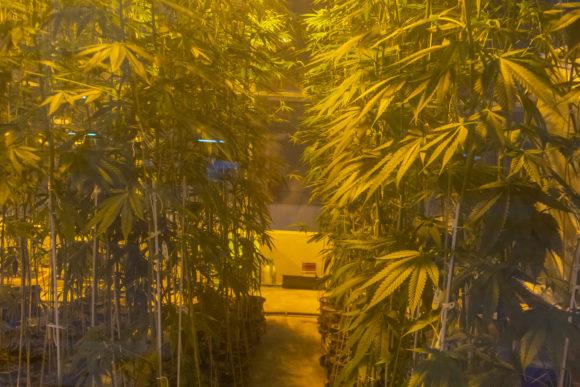GARDEN GROVE, Calif. — While California has a $1.4 billion legal marijuana market, a black market of perhaps equal size is thriving. Some enterprising growers are working on ways to get home insurers to cover their capital costs.
A presentation during the Combined Claims Conference Wednesday summarized the strategy: “The Growing Problem of Marijuana Grow Houses: Why are Insurance Claims Paying to Build Them, and Then Repair Them for Resale?”
Special Agent Mike McKee with the National Insurance Crime Bureau said organized criminal organizations are purchasing homes, often through overseas straw buyers. They start a fire and file a claim for damages. Using fire repairs as cover, the growers send in a construction crew to gut the interior of the house and install grow lights, ventilation and irrigation. Usually, the contractor bypasses the meter to save on electricity costs. Typically, no one lives in the home: Only marijuana plants.
Insurers get dragged into the scheme when the owner of the “grow house” buys an insurance policy for a rental property. When it’s time to shut down, the criminal organization submits a claim for damages — often through a public adjuster — saying that a tenant illegally converted the property without the owner’s knowledge.
McKee said each of the three grow house claims that he has investigated amounted to more than $250,000.
“The exposure on these can be enormous,” said attorney Jon Coleman, who participated in the panel discussion.
Recreational marijuana is legal in California, but six plants are allowed to be grown by each household. Grow house owners bypass the legal market, where the plants are grown in commercial facilities.
McKee said grow houses are scattered in neighborhoods throughout Southern California. The tell-tale signs: Window shades are always drawn, the interior and exterior lights are always on and the lawn is brown. There’s no sign of life in the home, except from time to time a car pulls into the garage and pulls out a short while later. (Some one has to check on the crop.)
Some insurers protect themselves from such schemes by specifically excluding coverage for damages caused by illegal growing operations. Mercury Insurance, however, does not.
Josh Leininger, special investigations unit supervisor for Mercury, said he has been involved in 15 to 20 investigations into suspected grow house claims. He said all but one them were filed by Chinese nationals who lived in Los Angeles County’s San Gabriel Valley and filed claims for damages to houses in San Bernardino and Riverside counties. The remaining suspected grow house claim involved a commercial office rented out by a former Mercury agent to a marijuana entrepreneur who did not disclose his intended use of the property.
Even though Mercury doesn’t yet have a policy exclusion for damages caused by growing marijuana, Mercury has been able to deny most of the claims by showing that the homeowner had lied on the insurance application.
“We are finding that they are buying the homes with no intention of actually living in it,” he said.
Leininger said his investigators look for several clues that homes are used to grow marijuana. The owner owns several homes but insures them with different carriers. The owner has several homes and lists them all as his primary residence. The insured’s mailing address is different that the address of the insured home.
To support its denial of suspected claims, Leininger said Mercury asks the claimant for copies of lease agreements, copies of cell phone records and credit card statements. Investigators ask the insured how he found the purported tenants.
“We’ve had a lot of success with these investigations,” he said.
The Combined Claims Conference concluded Wednesday.
Was this article valuable?
Here are more articles you may enjoy.


 CoreLogic Report Probes Evolving Severe Convective Storm Risk Landscape
CoreLogic Report Probes Evolving Severe Convective Storm Risk Landscape  Synopsys Sued by Private Equity Firm for Shopping $3 Billion Unit
Synopsys Sued by Private Equity Firm for Shopping $3 Billion Unit  Texas Among Several States Facing New Fire Risks: Weather Watch
Texas Among Several States Facing New Fire Risks: Weather Watch  EVs Head for Junkyard as Mechanic Shortage Inflates Repair Costs
EVs Head for Junkyard as Mechanic Shortage Inflates Repair Costs 